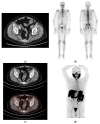Comparative Performance of 68Ga-PSMA-11 PET/CT and Conventional Imaging in the Primary Staging of High-Risk Prostate Cancer Patients Who Are Candidates for Radical Prostatectomy
- PMID: 39272748
- PMCID: PMC11394562
- DOI: 10.3390/diagnostics14171964
Comparative Performance of 68Ga-PSMA-11 PET/CT and Conventional Imaging in the Primary Staging of High-Risk Prostate Cancer Patients Who Are Candidates for Radical Prostatectomy
Abstract
This prospective study aimed to (1) compare the diagnostic performance of 68Ga-PSMA-11 PET/CT with respect to conventional imaging (computed tomography (CT) and bone scintigraphy (BS)) in the primary staging of high-risk prostate cancer (PCa) patients and (2) validate PSMA-PET/CT accuracy in pelvic nodal staging in comparison with postoperative histopathology and assess PSMA-PET/CT's impact on patient management. Sixty castration-sensitive high-risk (ISUP 4-5 and/or PSA > 20 ng/mL and/or cT3) PCa patients eligible for radical prostatectomy were enrolled (median PSA 10.10 [IQR: 6.22-17.95] ng/mL). PSMA-PET/CT, compared with CT, identified nodal (N) and/or distant metastases (M1) in 56.7% (34/60) vs. 13.3% (8/60) (p < 0.001) of patients: N + 45% vs. 13.3% (p < 0.001), M1a 11.7% vs. 1.7% (p = 0.03), M1b 23.3% vs. 1.7% (p < 0.001). Compared with BS, PSMA-PET/CT localized unknown skeletal metastases in 15% (9/60) of cases, with no false negative findings. Overall, PSMA-PET/CT led to a TNM upstaging in 45.0% (27/60) of cases, with no evidence of downstaging, resulting in a change in management in up to 28.8% (17/59) of patients. Compared with histopathology data (n = 32 patients), the per-patient accuracy of PSMA-PET/TC for detecting pelvic nodal metastases was 90.6%. Overall, the above evidence supports the use of PSMA-PET/CT in the diagnostic workup of high-risk prostate cancer staging.
Keywords: PSMA PET; conventional imaging; hormone-sensitive prostate cancer; positron emission tomography; primary staging; prostate cancer.
Conflict of interest statement
The authors declare no conflicts of interest.
Figures




References
-
- Afshar-Oromieh A., Holland-Letz T., Giesel F.L., Kratochwil C., Mier W., Haufe S., Debus N., Eder M., Eisenhut M., Schäfer M., et al. Diagnostic Performance of 68Ga-PSMA-11 (HBED-CC) PET/CT in Patients with Recurrent Prostate Cancer: Evaluation in 1007 Patients. Eur. J. Nucl. Med. Mol Imaging. 2017;44:1258–1268. doi: 10.1007/s00259-017-3711-7. - DOI - PMC - PubMed
-
- Fendler W.P., Calais J., Eiber M., Flavell R.R., Mishoe A., Feng F.Y., Nguyen H.G., Reiter R.E., Rettig M.B., Okamoto S., et al. Assessment of 68Ga-PSMA-11 PET Accuracy in Localizing Recurrent Prostate Cancer: A Prospective Single-Arm Clinical Trial. JAMA Oncol. 2019;5:856–863. doi: 10.1001/jamaoncol.2019.0096. - DOI - PMC - PubMed
-
- Pienta K.J., Gorin M.A., Rowe S.P., Carroll P.R., Pouliot F., Probst S., Saperstein L., Preston M.A., Alva A.S., Patnaik A., et al. A Phase 2/3 Prospective Multicenter Study of the Diagnostic Accuracy of Prostate Specific Membrane Antigen PET/CT with 18F-DCFPyL in Prostate Cancer Patients (OSPREY) J. Urol. 2021;206:52–61. doi: 10.1097/JU.0000000000001698. - DOI - PMC - PubMed
-
- Rovera G., Grimaldi S., Dall’Armellina S., Passera R., Oderda M., Iorio G.C., Guarneri A., Gontero P., Ricardi U., Deandreis D. Predictors of Bone Metastases at 68Ga-PSMA-11 PET/CT in Hormone-Sensitive Prostate Cancer (HSPC) Patients with Early Biochemical Recurrence or Persistence. Diagnostics. 2022;12:1309. doi: 10.3390/diagnostics12061309. - DOI - PMC - PubMed
-
- Ceci F., Rovera G., Iorio G.C., Guarneri A., Chiofalo V., Passera R., Oderda M., Dall’Armellina S., Liberini V., Grimaldi S., et al. Event-Free Survival after 68Ga-PSMA-11 PET/CT in Recurrent Hormone-Sensitive Prostate Cancer (HSPC) Patients Eligible for Salvage Therapy. Eur. J. Nucl. Med. Mol. Imaging. 2022;49:3257–3268. doi: 10.1007/s00259-022-05741-9. - DOI - PMC - PubMed
LinkOut - more resources
Full Text Sources
Miscellaneous

